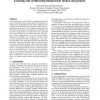Free Online Productivity Tools
i2Speak
i2Symbol
i2OCR
iTex2Img
iWeb2Print
iWeb2Shot
i2Type
iPdf2Split
iPdf2Merge
i2Bopomofo
i2Arabic
i2Style
i2Image
i2PDF
iLatex2Rtf
Sci2ools
FGR
2000
IEEE
2000
IEEE
Learning and Synthesizing Human Body Motion and Posture
A novel approach is presented for estimating human body posture and motion from a video sequence. Human pose is defined as the instantaneous image plane configuration of a single articulated body in terms of the position of a predetermined set of joints. First, statistical segmentation of the human bodies from the background is performed and low-level visual features are found given the segmented body shape. The goal is to be able to map these visual features to body configurations. Given a set of body motion sequences for training, a set of clusters is built in which each has statistically similar configurations. This unsupervised task is done using the Expectation Maximization algorithm. Then, for each of the clusters, a neural network is trained to build this mapping. Clustering body configurations improves the mapping accuracy. Given new visual features, a mapping from each cluster is performed providing a set of possible poses. From this set, the most likely pose is extracte...
| Added | 31 Jul 2010 |
| Updated | 31 Jul 2010 |
| Type | Conference |
| Year | 2000 |
| Where | FGR |
| Authors | Rómer Rosales, Stan Sclaroff |
Comments (0)

